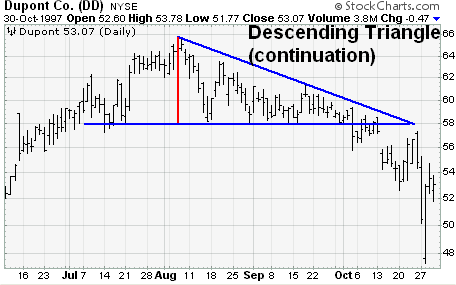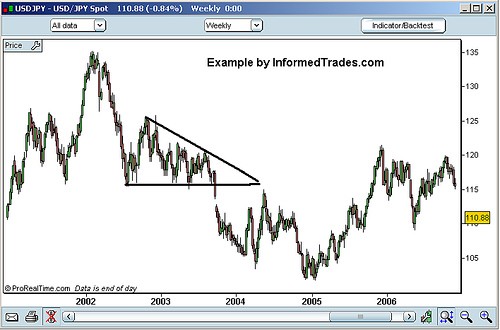Stock Technical Analysis Ascending Triangle
Post on: 25 Апрель, 2015 No Comment

A pattern that you will see swing traders use time and time again to make money is the Ascending Triangle. Stock technical analysis does not have to be complex or even difficult. In this lesson I will teach you more about the Ascending Triangle and how to trade it.
Stock Technical Analysis Basics
There are only three money making categories of chart patterns to trade: oversold, continuation, and breakout. This is also the progression that many chart patterns evolve through like the Ascending Triangle pattern.
The Ascending Triangle is a continuation pattern. Each progression in the Ascending Triangle is shown below.
The bullish Inverse Head and Shoulders pattern starts out as an oversold pattern and alternates between oversold and continuation patterns while it slowly builds the strength to end the pattern in an explosive breakout which releases the built up energy.
The classic Double Bottom pattern is a series of oversold and continuation patterns that may result in a breakout.
Technical Analysis of Stock Trends
Even an uptrend channel is really a sequence of oversold, continuation, and breakout patterns that repeat over and over again so as to form a series of higher lows and higher highs.
Stock Technical Analysis Tutorial
Here is something that you will not find in a stock technical analysis tutorial pdf. Try and view as many patterns as you can in terms of fitting into one of three patterns: oversold, continuation, or breakout. This simplifies your trading down to the essence of what are money making patterns. If you cant find an oversold, continuation, and then breakout pattern in a chart you are looking at then its probably not a chart you should be trading.
Most money making patterns begin with the oversold pattern which is why the oversold pattern is, and will always be, the best chart pattern to trade.
Frequently Asked Questions about Stock Technical Analysis Ascending Triangle
What is a ascending triangle?
An ascending triangle is when two trendlines converge where the upper line is horizontal while the lower line is rising.
The ascending triangle is a bullish continuation pattern that ultimately transitions into a breakout pattern.
The psychology of the ascending triangle pattern is that the bulls are able to take the price up to the horizontal resistance level repeatedly while the bears are slowly losing the ability to take the price back to the previous swing low.
Leavitt Brothers posted the awesome video below called Chart Patterns Ascending Triangles.
PerfectStockAlert.com posted the excellent video below called Ascending Triangle Chart Pattern.
How to trade ascending triangle.
The way most people trade the ascending triangle pattern is to wait for a breakout above the horizontal resistance level.
Sasha Evdakov shows this method for trading the ascending triangle in the excellent video below.
Jason Bond does NOT trade the ascending triangle like most people. If you want an advantage over most traders, you have to do things a little differently.
The breakout pattern is Jason Bonds least favorite pattern because you are always arriving to the party a little late that way. In other words, you are always chasing and buying after a lot of other traders. Instead, Jason Bond positions on an oversold RSI.
This is yet another reason why the oversold pattern is the best pattern to trade no matter what pattern forms on the chart. The oversold pattern is Jason Bonds favorite chart pattern.
Jason Bond posted the awesome video below called How To Make $10,000 In 10 Days Swing Trading.
What is a pivot point in stock technical analysis?
A pivot point is the average of the high, low, and closing prices from the previous trading day.
The most common method for calculating pivot points is called the five-point system. The five-point system uses the previous days low, high, and close, plus two resistance levels and two support levels (5 points total) to calculate the pivot point. Here is the calculation:
R2 = P + (H L) = P + (R1 S1)
R1 = (P x 2) L
P = (H + L + C) / 3
S1 = (P x 2) H
S2 = P (H L) = P (R1 S1)
Where H = the high, L = the low, and C = the close.

R1 and R2 are the resistance levels, P is the pivot point, and S1 and S2 are the support levels.
Most popular charting software will calculate the pivot point for you.
For example, on StockCharts.com, scroll down to the Overlays section and select Pivot Points:
When a stock is trading above its pivot point, there is a bullish bias. When a stock trades below its pivot point, there is a bearish bias.
Like all technical indicators, a pivot point system should be used with other forms of chart analysis. When Fibonacci retracement levels or an oversold RSI occur at a pivot point, S1, S2, R1, or R2 level, the more success you will have trading off of it.
MoneyShow.com posted the awesome video below called Common Mistakes When Trading with Pivot Levels.
Accendotraders posted the excellent video below called How to Use Pivot Points for Day Trading.
When does technical analysis not work?
Technical analysis does not work when a surprise external news event acts as a catalyst to move the stock either higher or lower. Support and resistance lines, channel lines, and candlestick patterns will react suddenly and will violate key levels because of a surprise external event. Think 911 in the U.S. or the Tsunami in Japan.
Technical analysis does not work when a single entity is manipulating the market such as with a penny stock pump and dump. Technical analysis is a reflection of the psychology of all market participants. When a single entity is manipulating the market, price no longer reflects market psychology but instead the psychology of the manipulator.
Jim Cramer, a money manager insider, talks about how single entities manipulate the market.
Technical analysis does not work if you are looking at the wrong technical indicators in the wrong kind of market. There are two major types of markets: a trading market, and a trending market. In a trading market you need to put more of a weighting on your oscillator indicators like the RSI, MACD, ROC, and CCI. In a trending market, you need to put more of a weighting on your trend following indicators like the accumulation/distribution line, ADX, and AROON.
Manny Backus posted the excellent video below called Trending or Trading?
When it comes to money making stock trading, simple is better. When you get to know traders who actually trade at home for a living like Jason Bond (JB). you learn to strip down your trading to simpler ways of looking at money making chart patterns that work over and over again.
In the video lesson below, you will hear Jason Bond (JB) teaching about the psychology behind the Ascending Triangle pattern.
IF YOU THINK THIS LESSON WAS GOOD, YOU OUGHT TO SEE WHAT ELSE JASON BOND (JB) HAS TO OFFER! CLICK HERE TO CHECK OUT HIS SERVICE! HES ON A HOT STREAK RIGHT NOW!
IF YOU THINK THIS LESSON WAS GOOD, YOU OUGHT TO SEE WHAT ELSE JASON BOND (JB) HAS TO OFFER! CLICK HERE TO CHECK OUT HIS SERVICE! HES ON A HOT STREAK RIGHT NOW!
Do you have a question about this lesson that is not already covered? Use the form below to send in your question.














